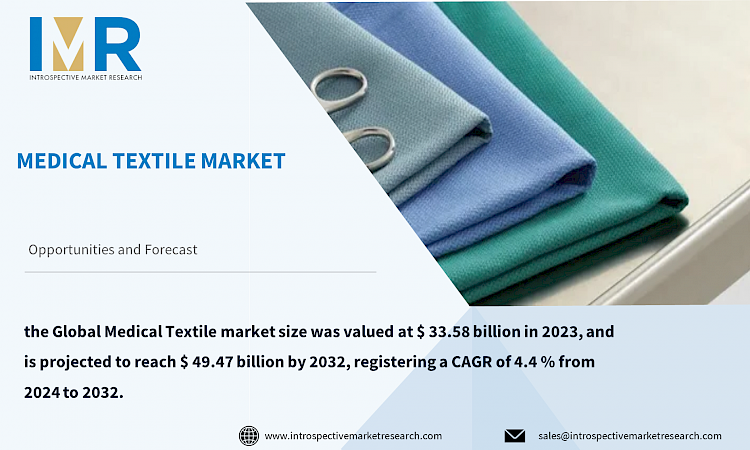
According to a new report published by Introspective Market Research, titled, ?Medical Textile Market by Bike Type, Sharing System, and User Type: Global Opportunity Analysis and Industry Forecast, 2024?2030,?
Global Medical Textile market size was valued at $ 33.58 billion in 2023, and is projected to reach $ 49.47 billion by 2032, registering a CAGR of 4.4 % from 2024 to 2032.
Medical textiles are specialized textile materials and products that are specifically designed and manufactured for use in healthcare and medical applications. These play crucial roles in medical settings, in hospitals, clinics, surgical centres, and home healthcare.
The market expansion has been fuelled by the rising awareness of Medical textiles among consumers. Medical textile helps to maintain moisture, and breathability along with comfort, barrier protection, and antimicrobial properties.
There is an increased awareness among consumers regarding healthcare as well as healthcare products such as wound care products, and hygiene products. The wound dressings, compression garments, and soft bedding materials are antimicrobial and disposable fabrics that can improve patients' care and safety from external contamination. There are sustainable options are also available in the market like eco-friendly, bio-degradable, and recycled materials. The medical textiles can protect wounds from external factors and maintain moisture.
Smart textiles are also known as e-textiles which are fabrics with advanced technology such as remote monitoring, and drug delivery. These technologically advanced textiles open up new opportunities for the medical textile market. The remote monitoring helps to monitor patients remotely, drug delivery system allows controlled medication of dosage helping to reduce oral or injection dosage. Smart textile can also sense moisture levels, temperature and pH balance. The motion sensors can detect sudden changes in body position and detect falls.
Global Medical Textile Market, Segmentation
The Medical Textile market is segmented based on Type, Form, End-user, Distribution Channel, and region.
Type:
Non-implantable medical textiles include products that are used externally such as surgical gowns, drapes, bandages, wound dressings, compression garments, and braces. These are designed to provide protection, support, and comfort to patients. In surgical procedures, there is a high demand for these textiles for ensuring patient safety and infection control. The wound dressings and bandages are designed to protect the wound, promote healing, and prevent infection. These are more accessible and widely used in healthcare settings compared to other segments.
Non-implantable medical textiles often provide cost-effective solutions compared to implantable or complex medical devices. The non-implantable segment dominates the medical textile market due to its wide range of applications, high demand, accessibility and widespread use, continuous advancements and innovation, and cost-effectiveness.
Form:
Non-woven fabrics offer versatility with high absorbency, making them ideal for use in wound care products where the fabric needs to absorb exudate from the wound. These fabrics are cost-effective compared to other textile forms and easier to manufacture, making them a preferred choice for large-scale production. Non-woven fabrics are often made from eco-friendly materials and are biodegradable and lightweight.
The aging population has led to an increased demand for medical textile products such as diapers, and adult underwear specially made with non-woven materials due to their absorbency and comfort. These fabrics are the ideal choice for masks, gowns, and other PPE as they can effectively block virus transmission. Also, with the growing trend towards disposable products, the demand for non-woven fabrics has increased. This emerged as a significant contributor to the overall medical textile market.
Region:
North America boasts a highly advanced healthcare infrastructure that facilitates the adoption and usage of medical products and technologies, including textiles. It has one of the highest healthcare expenditure rates globally where people are willing to pay for advanced medical technologies and products, including medical textiles, contributing to the market's dominance in the region. North America is known for its advanced research and development capabilities, technological innovations contributing to the development of medical products, including medical textiles, giving the region a competitive edge in the global market.
Some of The Active Market Players Are-
- Medline Industries, Inc. (United States)
- M?lnlycke Health Care (Sweden)
- Cardinal Health, Inc. (United States)
- Paul Hartmann AG (Germany)
- Winner Medical Co., Ltd. (China)
- KOB Medical Textile (Turkey)
- Johnson & Johnson Services, Inc. (United States)
- Dupont de Nemours, Inc. (United States)
- BSN Medical GmbH (Germany)
- The Medicom Group (Canada), and Other Active Players.
Key Industry Developments
- On 9 Jan 2024, Medline announced the latest addition to its advanced wound care portfolio, the OptiView? Transparent Dressing with HydroCore? Technology. This first-of-its-kind wound dressing features an innovative clear design that allows caregivers to quickly and easily inspect, monitor, and blanch skin with the dressing in place.
- On 9 Nov 2023, Cardinal Health announced the launch of its SmartGown? EDGE Breathable Surgical Gown with ASSIST? Instrument Pockets, created to provide surgical teams safe and convenient instrument access in the operating room. The gown is designed to hold one recommended instrument per pocket during surgical procedures, helping to provide handling efficiency and enabling clinical teams to focus on delivering safe patient care.
Key Findings of the Study
- Global Medical Textile market growth driven by increasing awareness about healthcare and healthcare products.
- Smart textile offers a significant opportunity to provide advanced features and maintain patients' comfort and safety.
- Non-woven fabrics offer versatility with high absorbency.
- North America is known for its advanced research and development capabilities, technological innovations contributing to the development of medical products, including medical textiles.





